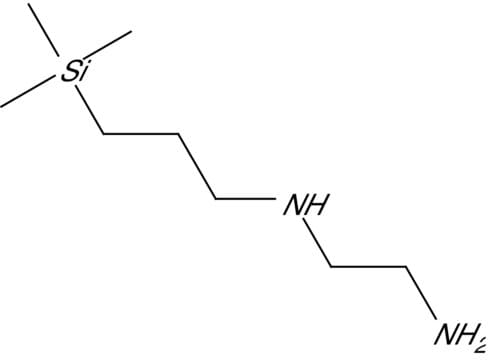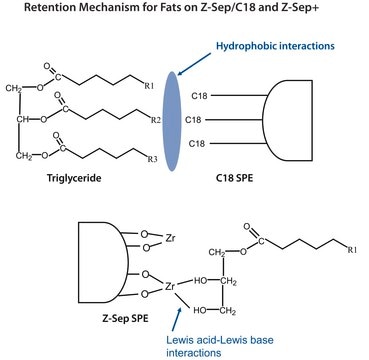Recommended Products
product line
Supelclean™
feature
endcapped
packaging
pkg of 100 g
extent of labeling
8.4% C
3.3% N loading
technique(s)
solid phase extraction (SPE): suitable
surface area
500 m2/g
surface coverage
surface coverage 2.35 μmol/m2
matrix
silica gel base material (irregularly shaped)
matrix active group
ethylenediamine-N-propy bonding
particle size
50 μm
pore size
70 Å pore size
pKa
(1) 10.1, (2) 10.9
capacity
0.98-1.05 meq/g capacity
application(s)
food and beverages
separation technique
ion exchange
normal phase
Related Categories
General description
Sample Matrix Compatibility: Organic or aqueous solutions
- Polymerically bonded, ethylenediamine-N-propyl phase that contains both primary and secondary amines
- A weak anion exchanger with a pKa of 10.1 and 10.9
- Similar to aminopropyl SPE phases (NH2) in terms of selectivity, but has a much higher capacity due to presence of secondary amine (0.98-1.05 meq/g)
- Strong affinity and high capacity for removing fatty acids, organic acids, and some polar pigments and sugars when conducting multi-residue pesticide analysis in foods
- Has been shown to significantly reduce matrix-enhancement effects encountered during the GC analysis of food products
- Tested for superior cleanliness using GC-FID and GC-MS
- Bidentate nature of ligand allows for chelation
Application
Legal Information
Signal Word
Danger
Hazard Statements
Precautionary Statements
Hazard Classifications
Eye Dam. 1 - Skin Sens. 1
Storage Class Code
11 - Combustible Solids
WGK
WGK 1
Flash Point(F)
Not applicable
Flash Point(C)
Not applicable
Certificates of Analysis (COA)
Search for Certificates of Analysis (COA) by entering the products Lot/Batch Number. Lot and Batch Numbers can be found on a product’s label following the words ‘Lot’ or ‘Batch’.
Already Own This Product?
Documents related to the products that you have purchased in the past have been gathered in the Document Library for your convenience.
Difficulty Finding Your Product Or Lot/Batch Number?
How to Find the Product Number
Product numbers are combined with Pack Sizes/Quantity when displayed on the website (example: T1503-25G). Please make sure you enter ONLY the product number in the Product Number field (example: T1503).
Example:
Additional examples:
705578-5MG-PW
PL860-CGA/SHF-1EA
MMYOMAG-74K-13
1000309185
enter as 1.000309185)
Having trouble? Feel free to contact Technical Service for assistance.
How to Find a Lot/Batch Number for COA
Lot and Batch Numbers can be found on a product's label following the words 'Lot' or 'Batch'.
Aldrich Products
For a lot number such as TO09019TO, enter it as 09019TO (without the first two letters 'TO').
For a lot number with a filling-code such as 05427ES-021, enter it as 05427ES (without the filling-code '-021').
For a lot number with a filling-code such as STBB0728K9, enter it as STBB0728 without the filling-code 'K9'.
Not Finding What You Are Looking For?
In some cases, a COA may not be available online. If your search was unable to find the COA you can request one.
Articles
SPE retention mechanism in this case is based on the electrostatic attraction of charged functional groups of the analyte(s) to oppositely charged functional groups on the sorbent.
Protocols
Extraction and Analysis of Agricultural Pesticides from Oranges Using the “QuEChERS” Method
Retention occurs through polar interaction between the sorbent and analytes. Typical sample matrices that can be employed in normal-phase SPE include hydrocarbon or fatty oils diluted in a solvent like hexane, isooctane, chlorinated solvent, THF, diethyl ether, or ethyl acetate.
Related Content
Solid phase extraction (SPE) is a technique used for rapid, selective sample preparation and purification prior to chromatographic analysis (e.g. HPLC, GC, TLC). SPE is used to exchange sample matrices, concentrate analytes, and remove interferences and contaminants to improve data and protect the analytical column.
Our team of scientists has experience in all areas of research including Life Science, Material Science, Chemical Synthesis, Chromatography, Analytical and many others.
Contact Technical Service



